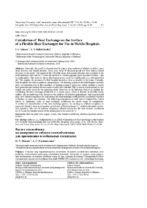| dc.contributor.author | Iokova, I. L. | |
| dc.contributor.author | Kalinichenko, A. S. | |
| dc.coverage.spatial | Минск | ru |
| dc.date.accessioned | 2020-02-05T12:26:22Z | |
| dc.date.available | 2020-02-05T12:26:22Z | |
| dc.date.issued | 2020 | |
| dc.identifier.citation | Iokova, I. L. Calculation of Heat Exchange on the Surface of a Flexible Heat Exchanger for Use in Mobile Hospitals = Расчет теплообмена на поверхности гибкого теплообменника для применения в мобильных госпиталях / I. L. Iokova, A. S. Kalinichenko // Энергетика. Известия высших учебных заведений и энергетических объединений СНГ. – 2020. – № 1. – С. 81-88. | ru |
| dc.identifier.uri | https://rep.bntu.by/handle/data/63844 | |
| dc.description.abstract | Currently, the world is characterized by quite a large number of military conflicts, manmade disasters and natural disasters. Every year, about 50 thousand people die from various natural disasters in the world. The report of the UNISDR notes that natural disasters that occurred in the world between 1998 and 2017 led to the death of 1.3 million people (more than half of them – due to earthquakes). The analysis shows that human losses could be significantly less with rapid first aid. This requires the presence of a field hospital located as close as possible to the lesion. Currently, field hospitals for various purposes are produced. The heating system of the field hospital modules plays an important role in the operation. A heating system is proposed, which includes a vortex heat generator and heating devices made of polyvinyl chloride. The system is characterized by low weight and quick access to the operating mode. However, in the literature there is no method for calculating the heat exchange coefficient in a closed space, which is formed by flexible heater surface and an enclosing wall. Based on the analysis of criterion dependences and experimental data, new criterion equations for calculating the heat exchange coefficient for an arbitrary location of heaters in space are obtained. The following dependence is built lgNu = f(lg(Gr⋅Pr)), which allows to determine value of heat exchange coefficient for given range of temperature. A method of intensification of the heat exchange process by creating an artificial roughness is proposed. Graph is done to determine growth rate of heat exchange СK, which is included in criterion equation. The use of artificial roughness allowed increasing the heat transfer coefficient by 28 % and the thermal power of the heating device by about 26 %. | ru |
| dc.language.iso | en | ru |
| dc.publisher | БНТУ | ru |
| dc.title | Calculation of Heat Exchange on the Surface of a Flexible Heat Exchanger for Use in Mobile Hospitals | ru |
| dc.title.alternative | Расчет теплообмена на поверхности гибкого теплообменника для применения в мобильных госпиталях | ru |
| dc.type | Article | ru |
| dc.identifier.doi | 10.21122/1029-7448-2020-63-1-81-88 | |
| local.description.annotation | Сегодня мир характеризуется достаточно большим количеством военных конфликтов, техногенных катастроф, стихийных бедствий. Ежегодно от разного рода природных катаклизмов на планете погибает около 50 тыс. человек. В докладе Управления ООН по уменьшению опасности стихийных бедствий (ЮНИСДР) отмечается, что стихийные бедствия, человек (свыше половины из них – из-за землетрясений). Анализ показывает, что людские потери могли бы быть значительно меньше при быстром оказании первой медицинской помощи. Это требует наличия госпиталя, расположенного как можно ближе к очагу поражения. В настоящее время создаются полевые госпитали различного назначения. Важную роль в их функционировании играет система обогрева модулей. Предложена система отопления, которая включает в себя вихревой теплогенератор и нагревательные приборы из поливинилхлорида. Система отличается малым весом и быстрым выходом в рабочий режим. Однако в литературе отсутствует методика расчета коэффициента теплоотдачи в замкнутом пространстве, образованном поверхностью гибкого нагревателя и ограждающей стеной. На основе анализа зависимостей и экспериментальных данных получены новые критериальные уравнения для расчета коэффициента теплоотдачи для произвольного расположения нагревателей в пространстве. Построена зависимость lgNu = f(lg(Gr⋅Pr)), которая позволяет определить величину коэффициента теплоотдачи для заданной области температуры. Предложен способ интенсификации процесса теплообмена за счет создания искусственной шероховатости. Построен график для определения доли роста теплоотдачи СK, входящей в критериальное уравнение. Применение искусственной шероховатости позволило увеличить коэффициент теплоотдачи на 28 %, а тепловую мощность нагревательного прибора – примерно на 26 %. | ru |

